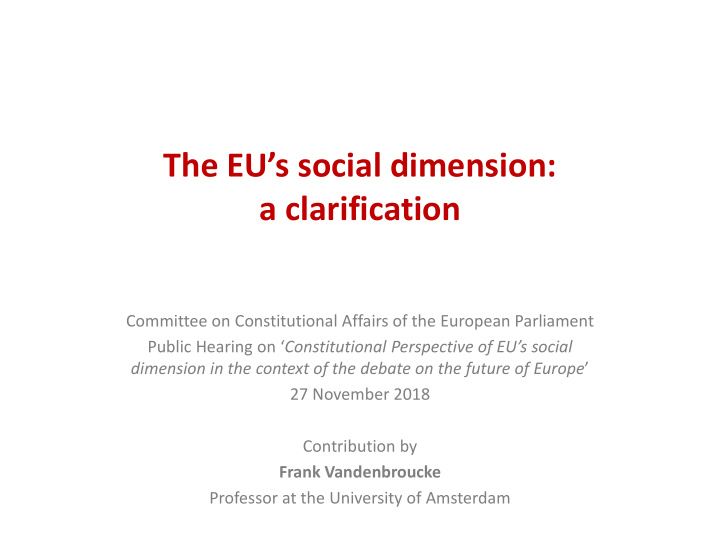



The EU’s social dimension: a clarification Committee on Constitutional Affairs of the European Parliament Public Hearing on ‘ Constitutional Perspective of EU’s social dimension in the context of the debate on the future of Europe ’ 27 November 2018 Contribution by Frank Vandenbroucke Professor at the University of Amsterdam
The elusive notion of ‘Social Europe’…
A European Social Union A Social Union would • support national welfare states on a systemic level in some of their key functions (e.g. stabilization, fair corporate taxation, …) • guide the substantive development of national welfare states – via general social standards and objectives, leaving ways and means of social policy to Member States – on the basis of an operational definition of ‘the European social model’. ⇒ European countries would cooperate in a union with an explicit social purpose, pursuing both national and pan-European social cohesion, ⇒ reconnecting with the original inspiration of the founding fathers, ⇒ based on reciprocity (no solidarity without responsibility) and subsidiarity.
EMU: the challenge of stabilization • Why are stabilization instruments centralized in monetary unions? • Minimum requirements for an effective stabilisation capacity within EMU member states: – sufficiently generous unemployment benefits, notably in the short-term; – sufficient coverage rates of unemployment benefit schemes; – no labour market segmentation that leaves part of the labour force poorly insured; – no proliferation of employment relations that are not integrated into social insurance; – effective activation of unemployed individuals; – budgetary buffers in good times, so that automatic stabilisers can do their work in bad times. • These principles become a fortiori imperative, if the Eurozone would be equipped with automatic stabilizers that are triggered, in one or other way, by unemployment shocks (to avoid institutional moral hazard)
EMU: common standards for resilient welfare states • A shared conception of flexibility • Labour market institutions that can deliver on wage coordination (effective collective bargaining) • Cluster of policy principles for an adequate stabilisation capacity in MS: – sufficiently generous unemployment benefits, notably in the short-term; – sufficient coverage rates of unemployment benefit schemes; – no labour market segmentation that leaves part of the labour force poorly insured against unemployment; – no proliferation of employment relations that are not integrated into systems of social insurance; – effective activation of unemployed individuals ⇒ Convergence in some , key features of Eurozone welfare states ⇒ European Pillar of Social Rights , Gothenburg Summit, 17 November 2017
EU27: a ‘balancing act’ to reconcile openness and domestic cohesion • A regulatory framework for ‘fair mobility’ • Access to social benefits: the general principle of non-discrimination • The (necessary) exception: posting of workers • Transparency and coverage of minimum wage regimes => European Pillar of Social Rights
How to deliver on the European Pillar of Social Rights? • Clear priorities • Credible roadmap, combining… – EU legislation – Policy coordination and benchmarking – Funding instruments (tangible support for MS) • Mainstreaming in economic and fiscal surveillance, European Semester • Completing EMU as an insurance union
Resources 1) Vandenbroucke, Barnard, De Baere (eds.), A European Social Union after the Crisis , Cambridge: Cambridge University Press, September 2017. https://doi.org/10.1017/9781108235174 1) Introductory chapter in Open Access on www.frankvandenbroucke.uva.nl, item 263; 2) Part III, Legal and Institutional Challenges 2) Vandenbroucke , Social policy in a monetary union: puzzles, paradoxes and perspectives, in: Boone, Marc; Deneckere, Gita & Tollebeek, Jo (eds.), The End of Postwar and the Future of Europe - Essays on the work of Ian Buruma , Verhandelingen van de KVAB voor Wetenschappen en Kunsten. Nieuwe reeks, 31, Uitgeverij Peeters, 2017; accessible on www.frankvandenbroucke.uva.nl; 3) Vandenbroucke, Structural convergence versus systems competition: limits to the diversity of labour market policies in the European Economic and Monetary Union , ECFIN discussion paper 065, European Commission Directorate-General for Economic and Financial Affairs, Brussels, 20 July 2017, accessible on www.frankvandenbroucke.uva.nl
Recommend
More recommend